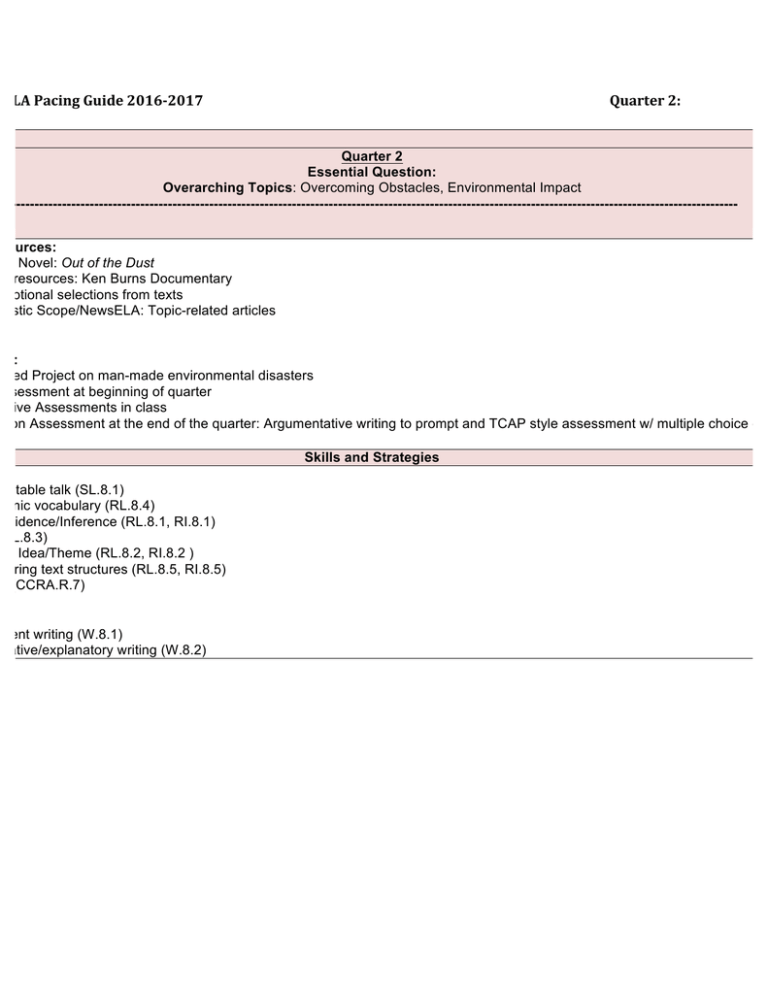th Grade ELA Pacing Guide 2016
advertisement

eELAPacingGuide2016-2017 Quarter2: Quarter 2 Essential Question: Overarching Topics: Overcoming Obstacles, Environmental Impact --------------------------------------------------------------------------------------------------------------------------------------------------------------- elf: sources: ed Novel: Out of the Dust ne resources: Ken Burns Documentary Optional selections from texts olastic Scope/NewsELA: Topic-related articles r: nts: nded Project on man-made environmental disasters assessment at beginning of quarter mative Assessments in class mon Assessment at the end of the quarter: Argumentative writing to prompt and TCAP style assessment w/ multiple choice que ountable talk (SL.8.1) demic vocabulary (RL.8.4) evidence/Inference (RL.8.1, RI.8.1) (RL.8.3) ral Idea/Theme (RL.8.2, RI.8.2 ) paring text structures (RL.8.5, RI.8.5) a (CCRA.R.7) ment writing (W.8.1) mative/explanatory writing (W.8.2) Skills and Strategies eELAPacingGuide2016-2017 Quarter2: ng clarity (W.8.4) t research projects (W.8.7) ventions of English: Grammar (L.8.1) ventions of English: Mechanics (L.8.2) e and passive voice (L.8.3) rative language (L.8.5) Q2 Standards Dates Assessed Forms of Assessm Cite textual evidence to support analysis of what the text says explicitly as well as rawn from text. Formative Assessment Common Assessment ermine a theme or central idea of a text and analyze its development over the course ncluding its relationship to the characters, setting, and plot; provide an objective the text. Formative Assessment Common Assessment ermine a theme or central idea of a text and analyze its development over the course cluding its relationship to supporting ideas; provide an objective summary of the text. Formative Assessment Common Assessment lyze how particular elements of a story or drama interact (e.g., how setting shapes the r plot). Formative Assessment Common Assessment yze how a text makes connections among and distinctions between individuals, ideas, .g., through comparisons, analogies, or categories). Formative Assessment Common Assessment Determine the meaning of words and phrases as they are used in a text, including d connotative meanings; analyze the impact of specific word choices on meaning and ng analogies or allusions to other texts. Formative Assessment Common Assessment mpare and contrast the structure of two or more texts and analyze how the differing each text contributes to its meaning and style. Formative Assessment Common Assessment eELAPacingGuide2016-2017 Quarter2: rmine an author's point of view or purpose in a text and analyze how the author es and responds to conflicting evidence or viewpoints. Formative Assessment Common Assessment uate the advantages and disadvantages of using different mediums (e.g., print or video, multimedia) to present a particular topic or idea. Formative Assessment Common Assessment e arguments to support claims with clear reasons and relevant evidence. Argument essay e informative/explanatory texts to examine a topic and convey ideas, concepts, and through the selection, organization, and analysis of relevant content. RACE Writing/Formative Common Assessment uce clear and coherent writing in which the development, organization, and style are to task, purpose, and audience. Formative Assessment m and use verbs in the active and passive voice. Formative Assessment Common Assessment onstrate command of the conventions of standard English capitalization, punctuation, when writing Formative Assessment Common Assessment verbs in the active and passive voice and in the conditional and subjunctive mood to icular effects (e.g., emphasizing the actor or the action; expressing uncertainty or state contrary to fact). mine or clarify the meaning of unknown and multiple-meaning words or phrases ade 8 reading and content, choosing flexibly from a range of strategies. Formative Assessment Common Assessment Formative Assessment Common Assessment onstrate understanding of figurative language, word relationships, and nuances in ngs. Formative Assessment Common Assessment Ongoing Standards the end of the year, read and comprehend literary nonfiction in the grades 6-8 text band proficiently, with scaffolding as needed at the high end of the range. eELAPacingGuide2016-2017 Quarter2: some guidance and support from peers and adults, develop and strengthen writing as planning, revising, editing, rewriting, or trying a new approach, focusing on how well d audience have been addressed. technology, including the Internet, to produce and publish writing and present the s between information and ideas efficiently as well as to interact and collaborate with duct short research projects to answer a question (including a self-generated rawing on several sources and generating additional related, focused questions that ltiple avenues of exploration. er relevant information from multiple print and digital sources, using search terms assess the credibility and accuracy of each source; and quote or paraphrase the data ions of others while avoiding plagiarism and following a standard format for citation. ite routinely over extended time frames (time for research, reflection, and revision) time frames (a single sitting or a day or two) for a range of discipline-specific tasks, nd audiences. onstrate command of the conventions of standard English capitalization, punctuation, when writing. re and use accurately grade-appropriate general academic and domain-specific hrases; gather vocabulary knowledge when considering a word or phrase important ension or expression. ge effectively in a range of collaborative discussions (one-on-one, in groups, and with diverse partners on grade 8 topics, texts, and issues, building on others' ideas ing their own clearly. yze the purpose of information presented in diverse media and formats (e.g., visually, y, orally) and evaluate the motives (e.g., social, commercial, political) behind its n. ent claims and findings, emphasizing salient points in a focused, coherent manner with dence, sound valid reasoning, and well-chosen details; use appropriate eye contact, olume, and clear pronunciation. rate multimedia and visual displays into presentations to clarify information, claims and evidence, and add interest. Whole class discussion, collaborative group work Whole class discussion, collaborative group work Individual and group presentations Individual and group presentations